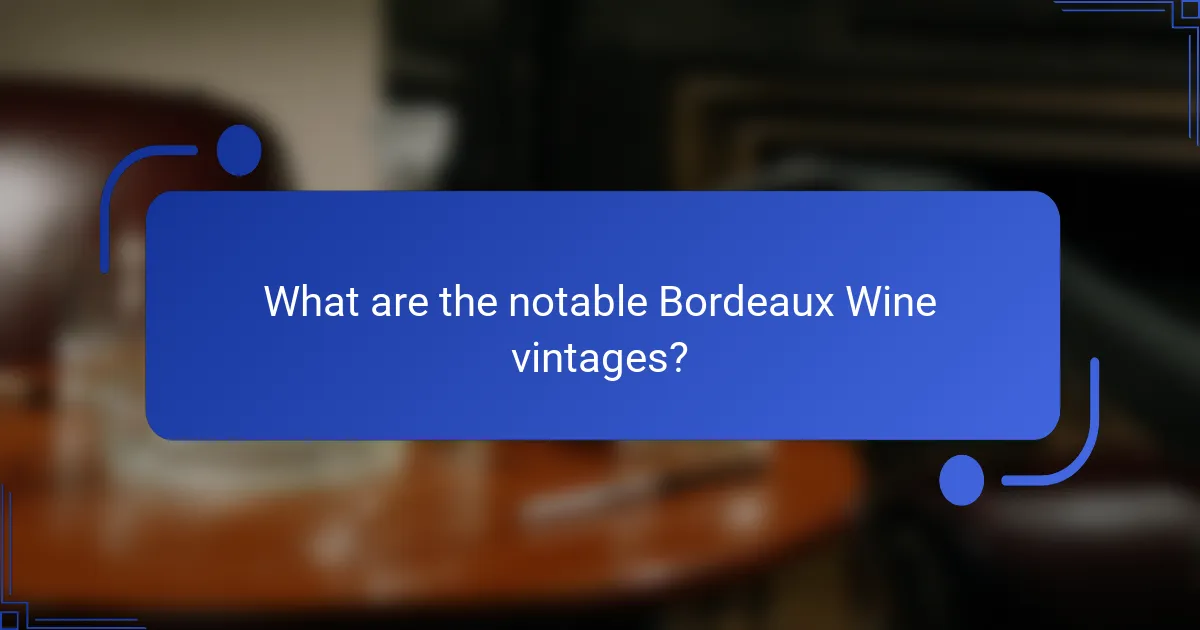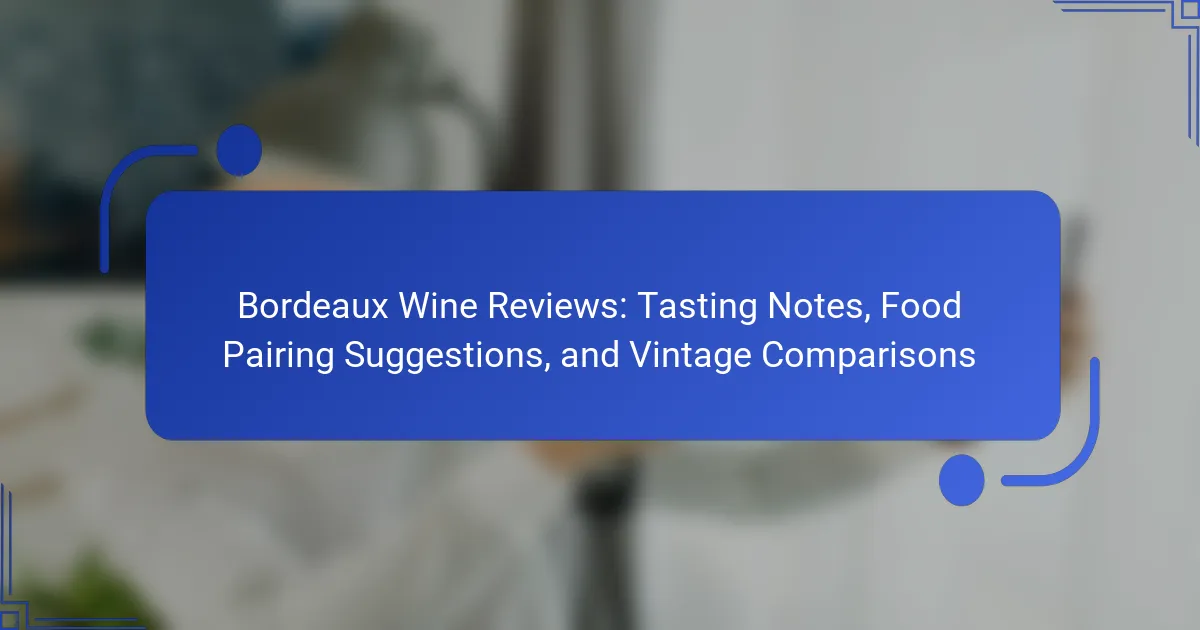
What is Bordeaux Wine?
Bordeaux wine is a type of wine produced in the Bordeaux region of France. It is known for its rich flavors and complexity. The region primarily produces red, white, and rosé wines. Red Bordeaux wines are typically blends of grape varieties like Merlot, Cabernet Sauvignon, and Cabernet Franc. White Bordeaux wines are generally made from Sauvignon Blanc, Sémillon, and Muscadelle grapes. Bordeaux wines have a long history, dating back to Roman times. The region’s unique terroir contributes to the wines’ distinctive characteristics. Bordeaux is one of the most famous wine regions globally, recognized for its prestigious châteaux and classifications.
How is Bordeaux Wine produced?
Bordeaux wine is produced through a meticulous process involving several key steps. First, grapes are harvested from vineyards in the Bordeaux region of France. The primary grape varieties used include Merlot, Cabernet Sauvignon, and Cabernet Franc. After harvesting, the grapes are sorted to remove any damaged or unripe fruit.
Next, the grapes undergo crushing and destemming to extract the juice. This juice is then fermented in stainless steel or oak barrels. During fermentation, yeast converts sugars into alcohol, which typically lasts from one to three weeks.
After fermentation, the wine is pressed to separate the liquid from the solids. The wine is then aged in barrels, which can last from several months to several years. Aging in oak barrels adds complexity and flavor to the wine.
Finally, the wine is filtered and bottled. Bordeaux wines are often blended, combining different grape varieties to achieve a balanced flavor profile. This method of production has been refined over centuries, ensuring the quality and reputation of Bordeaux wines.
What grape varieties are commonly used in Bordeaux wines?
Bordeaux wines commonly use Cabernet Sauvignon, Merlot, and Cabernet Franc as grape varieties. These varieties contribute to the region’s distinctive flavor profiles. Cabernet Sauvignon offers structure and tannins. Merlot provides softness and fruitiness. Cabernet Franc adds aromatic complexity. Other varieties include Petit Verdot, Malbec, and Carménère, but they are used less frequently. Bordeaux’s climate and soil enhance the characteristics of these grapes. The blend of these varieties creates the rich, diverse wines Bordeaux is known for.
What are the key characteristics of Bordeaux wine production regions?
Bordeaux wine production regions are characterized by their distinct climate, soil types, and grape varieties. The region experiences a maritime climate, which provides moderate temperatures and sufficient rainfall. This climate is conducive to growing high-quality grapes. Bordeaux soils vary significantly, including gravel, clay, and limestone, contributing to the unique flavor profiles of the wines. The primary grape varieties include Cabernet Sauvignon, Merlot, and Cabernet Franc, which are essential for producing the region’s renowned red wines. Bordeaux is also known for its classification system, which ranks châteaux based on historical quality and reputation. This classification influences market value and consumer perception. The region’s diverse sub-regions, such as Médoc, Saint-Émilion, and Pomerol, each offer unique characteristics and styles of wine. These factors combine to create Bordeaux’s esteemed reputation in the wine industry.
What are the tasting notes of Bordeaux Wine?
Bordeaux wine typically features tasting notes of dark fruits, such as blackberry, plum, and black currant. These wines often exhibit earthy undertones, including notes of tobacco and leather. Additionally, Bordeaux wines can present hints of spice, such as clove and pepper. Many examples also showcase floral aromas like violet. The tannins in Bordeaux wines are usually firm, contributing to a structured mouthfeel. Aging in oak barrels adds complexity, introducing flavors of vanilla and cedar. The balance of acidity in Bordeaux wines enhances their overall freshness. These characteristics vary by region within Bordeaux, such as Médoc or Saint-Émilion, influencing the profile of each wine.
How do the flavors of Bordeaux wines vary by region?
Bordeaux wines exhibit diverse flavors that vary significantly by region. The Left Bank, particularly in areas like Médoc, is known for Cabernet Sauvignon-dominant blends. These wines often present flavors of blackcurrant, cedar, and tobacco. In contrast, the Right Bank, especially in Saint-Émilion and Pomerol, favors Merlot. This results in wines with softer tannins and flavors of plum, chocolate, and spice. The Entre-Deux-Mers region produces white Bordeaux wines with fresh citrus and floral notes. Additionally, the terroir, including soil type and climate, influences these flavor profiles. Historical practices and grape varietals also play a role in defining regional characteristics. Thus, the variation in flavors across Bordeaux regions is rooted in both grape composition and local environmental factors.
What aromas can be expected in different Bordeaux vintages?
Bordeaux vintages exhibit a range of aromas influenced by the year and weather conditions. For example, cooler years often yield wines with fresh fruit aromas such as cherry and raspberry. Warmer vintages typically produce riper fruit scents, including plum and blackberry.
In addition, vintages with more rainfall may have earthy notes, like mushroom or wet soil. Drier years can enhance floral aromas, such as violet or rose.
Aromas of oak, vanilla, and spice are common in many Bordeaux wines due to barrel aging. These characteristics can vary significantly based on the specific vintage and the winemaker’s techniques.
Each vintage tells a unique aromatic story, reflecting its climatic conditions and terroir.
Why are Bordeaux Wine reviews important?
Bordeaux wine reviews are important because they provide critical insights into the quality and characteristics of the wine. These reviews assess various attributes, such as flavor profile, aroma, and aging potential. They help consumers make informed purchasing decisions. Additionally, reviews often include expert opinions and ratings that can influence market value. Historical data shows that wines with higher review scores tend to sell for significantly more. Bordeaux wines have a reputation for complexity, making reviews essential for understanding their nuances. Overall, reviews serve as a guide for both novice and experienced wine enthusiasts.
How do wine critics evaluate Bordeaux wines?
Wine critics evaluate Bordeaux wines through a systematic tasting process. They assess visual appearance, aroma, taste, and finish. Critics often look for clarity and color intensity in the wine. Aromas are analyzed for complexity and fruitiness. The palate evaluation includes balance, acidity, tannins, and flavor depth. Finish length is also considered, as it indicates quality. Critics may reference established scoring systems, such as the 100-point scale. Historical context, vineyard reputation, and vintage characteristics also inform their evaluations. This thorough approach helps ensure accurate and reliable wine reviews.
What role do consumer reviews play in Bordeaux wine appreciation?
Consumer reviews significantly influence Bordeaux wine appreciation. They provide insights into personal experiences with specific wines. Reviews often highlight taste profiles, aromas, and overall satisfaction. This information aids potential buyers in making informed decisions. Research indicates that 79% of consumers trust online reviews as much as personal recommendations. Positive reviews can enhance a wine’s reputation and increase sales. Conversely, negative reviews can deter customers from purchasing. Thus, consumer reviews serve as a critical tool in shaping perceptions of Bordeaux wines.

What food pairings complement Bordeaux Wine?
Bordeaux wine pairs well with red meats, especially beef and lamb. The tannins in Bordeaux complement the richness of these meats. Game dishes, such as venison, also enhance the wine’s flavors. Additionally, Bordeaux wine goes well with hearty dishes like stews. Cheeses, particularly aged varieties like cheddar and blue cheese, match well with Bordeaux. Grilled vegetables can provide a nice contrast to the wine’s profile. Rich sauces, such as those made with mushrooms or red wine reductions, further elevate the pairing experience. These combinations are widely recognized among sommeliers and food enthusiasts.
How do different Bordeaux wines pair with food?
Bordeaux wines pair with food based on their specific characteristics. Red Bordeaux, primarily made from Cabernet Sauvignon and Merlot, complements red meats like beef and lamb. The tannins in these wines enhance the flavors of grilled or roasted dishes. White Bordeaux, often made from Sauvignon Blanc and Sémillon, pairs well with seafood and poultry. The acidity in white Bordeaux balances the richness of these foods. Sweet Bordeaux wines, such as Sauternes, match desserts and blue cheeses. Their sweetness contrasts beautifully with salty or creamy flavors. Each type of Bordeaux wine offers unique pairing opportunities that enhance the dining experience.
What are the best food pairings for red Bordeaux wines?
Red Bordeaux wines pair best with rich dishes. Classic pairings include grilled meats, especially lamb and beef. They complement roasted game birds and duck as well. Red Bordeaux also works well with hearty stews and braised dishes. Aged cheeses, like cheddar and Gruyère, enhance the wine’s flavors. Dark chocolate desserts can create a delightful contrast. These pairings are supported by the wine’s tannins and acidity, which balance fat and enhance flavors.
What dishes complement white Bordeaux wines?
White Bordeaux wines pair well with seafood dishes. Dishes such as grilled fish, oysters, and shrimp are ideal. They enhance the wine’s crisp acidity and fruit notes. Poultry dishes like roasted chicken also complement white Bordeaux. The wine’s complexity balances the flavors of the chicken. Creamy sauces with pasta are another excellent match. The richness of the sauce pairs well with the wine’s structure. Salads with citrus dressings can also be a refreshing choice. The acidity in the wine matches the brightness of the salad.
Why is understanding food pairings essential for Bordeaux Wine enjoyment?
Understanding food pairings is essential for Bordeaux Wine enjoyment because it enhances the overall tasting experience. Bordeaux wines have complex flavor profiles that can be complemented or contrasted by various foods. For instance, a full-bodied Cabernet Sauvignon pairs well with rich meats like beef or lamb. This pairing allows the wine’s tannins to soften and the fruit flavors to emerge more prominently. Additionally, lighter Bordeaux varieties, such as Merlot, can be enjoyed with poultry or dishes featuring mushrooms, which highlight the wine’s subtle nuances. Studies show that the right food pairing can elevate the perception of wine flavors by balancing acidity and sweetness. Therefore, understanding these pairings leads to a more enjoyable and satisfying experience when consuming Bordeaux wines.
How does food affect the tasting experience of Bordeaux Wine?
Food significantly influences the tasting experience of Bordeaux wine. The interaction between food and wine can enhance or diminish flavors. For example, fatty foods can soften tannins in red Bordeaux, making the wine taste smoother. Salty dishes can amplify fruitiness and balance acidity in the wine. Spicy foods may clash with the wine’s structure, leading to an unbalanced experience.
Pairing Bordeaux with rich meats, like lamb or beef, complements its robust profile. Aged cheeses also enhance the wine’s complexity. Studies show that food pairing can elevate the overall sensory experience of wine. The right food can bring out hidden notes in Bordeaux, creating a harmonious tasting experience.

What are the notable Bordeaux Wine vintages?
Notable Bordeaux wine vintages include 1945, 1961, 1982, 1990, 2000, 2005, 2009, and 2010. The 1945 vintage is often celebrated for its exceptional quality and rarity. The 1961 vintage is known for its rich, full-bodied wines. The 1982 vintage marked a turning point in Bordeaux’s reputation for quality. The 1990 vintage produced ripe, opulent wines with great aging potential. The 2000 vintage is recognized for its balance and structure. The 2005 vintage is lauded for its concentration and depth. The 2009 vintage is characterized by its ripe fruit and approachability. Lastly, the 2010 vintage is praised for its freshness and complexity. Each of these vintages has received high ratings from wine critics and collectors.
How do vintage conditions impact Bordeaux Wine quality?
Vintage conditions significantly impact Bordeaux wine quality. Weather factors such as temperature, rainfall, and sunlight during the growing season influence grape ripeness. For instance, a warm and dry vintage typically results in ripe, concentrated flavors in the wine. Conversely, a cool and wet vintage can lead to diluted flavors and higher acidity. Historical data shows that the 2005 vintage, characterized by ideal weather, produced exceptional wines praised for their balance and aging potential. In contrast, the 2013 vintage, marked by excessive rain, resulted in lower quality wines with less complexity. Thus, vintage conditions play a crucial role in determining the overall quality of Bordeaux wines.
What were the standout years for Bordeaux wines in recent history?
Standout years for Bordeaux wines in recent history include 2005, 2009, 2010, 2015, and 2016. The year 2005 is noted for its exceptional quality and balance. In 2009, favorable weather conditions led to ripe, concentrated wines. The 2010 vintage is praised for its structure and aging potential. The 2015 year produced wines with richness and elegance. Lastly, 2016 is recognized for its freshness and complexity. These vintages are often highlighted in wine reviews for their outstanding characteristics and aging capabilities.
How can vintage comparisons guide wine selection?
Vintage comparisons can guide wine selection by highlighting the quality and characteristics of wines from different years. Each vintage reflects specific weather conditions that influence grape ripeness and flavor profiles. For instance, a warm vintage may yield fruitier wines, while a cooler year might produce more acidic options.
Wine critics often provide ratings and tasting notes for each vintage, helping consumers make informed choices. Historical data shows that certain vintages, like 2005 and 2010 in Bordeaux, are renowned for their exceptional quality. This information allows buyers to prioritize wines from highly rated years when selecting bottles.
Additionally, understanding vintage trends can help in pairing wines with food. For example, a robust vintage might complement hearty dishes better than a lighter year. Ultimately, vintage comparisons serve as a valuable tool for selecting wines that suit personal preferences and dining occasions.
What should consumers consider when choosing a Bordeaux Wine vintage?
Consumers should consider the vintage’s climate conditions and growing season when choosing a Bordeaux wine. The weather significantly affects grape quality and wine characteristics. For example, the 2010 vintage is praised for its exceptional weather, resulting in high-quality wines. Additionally, consumers should evaluate the aging potential of the vintage. Some years produce wines that age well, while others are best enjoyed young. The 2005 vintage is noted for its longevity and complexity. Lastly, consumers should research the reputation of specific châteaux in different years. Certain producers consistently perform well, making their wines more reliable choices. Understanding these factors helps consumers select a Bordeaux wine vintage that meets their preferences.
How can vintage charts assist in making informed purchasing decisions?
Vintage charts provide essential data for making informed purchasing decisions in Bordeaux wine. These charts detail the quality and characteristics of specific vintages. They indicate factors such as climate conditions and harvest quality. For example, a vintage chart may show that 2010 was an exceptional year for Bordeaux wines. This information helps buyers understand which years produced the best wines. Additionally, vintage charts can highlight price trends over time. This allows consumers to assess whether a wine’s current price is justified. By using vintage charts, buyers can make educated choices based on historical performance. This ultimately leads to better investment in quality wines.
Bordeaux wine is a renowned type of wine produced in the Bordeaux region of France, characterized by its rich flavors and complexity. This article covers key aspects of Bordeaux wine, including its production process, commonly used grape varieties, and distinctive characteristics of different regions. It also explores tasting notes, food pairing suggestions, and the importance of vintage conditions and reviews in evaluating Bordeaux wines. Additionally, readers will find insights into notable vintages and how they impact wine quality, guiding informed purchasing decisions.
